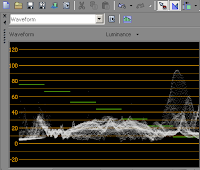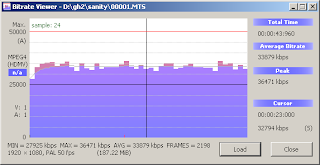It rarely goes above 12Mbit/sec.
I did a couple of test shoots and found the problem: the camera drops the bitrate if the foreground is dark. Remember what every consumer has been brainwashed into? Have the light behind you. Put the flash on the camera. Have the sun behind you. In more professional terms: keep the key behind the camera. Well, we all know how that looks: crap! Cinematic lighting is often with the key at very steep angles or from behind the subject. It looks best if the sun is behind the subject and we bounce light back into his/her face.
In the example above it's an HMI clamped on the door suggesting a practical light clamped there (and therefore deliberately not hiding the cable). INT daytime lighting is usually against a window so that the subject's face is often pretty dark.
There are numerous patches available for the GH2 from the site Personal View. It's an excellent site and I encourage to donate to the project. After having tried out most of the patches I can only recommend the so called "Sanity pach" from their page or it can be downloaded also here. This patch produces nearly constant bitrate no matter if the foreground is dark or not. Any other patches (flowmotion, aq4, vanilla, intra x, ...) perform well shooting grass, bushes and other detailed patterns but drop the bitrate drastically in underexposed areas and look exactly as the original HBR mode -- and I rarely shoot bushes in my films.
Some of the patches waste over 100Mbit/sec and still look terribly blocky. It feels a bit like these audio-philes who claim that only a cable with a diameter of 10cm (used to power a whole village) sounds perfect connecting the amp and the loudspeaker forgetting that the mechanics of the speaker introduces >1% distortion. Anyway. Coming back to the cinematic lighting:
Here we have a still from "Mirrorgod" (with Jamie Lee McPherson). It has a similar brightness profile as the shot above
 but this time we have no compression artefacts at all (again click on the image to enlarge). This has been shot with the Sanity patch. It only drops the bitrate when it's completely pitch black but otherwise it always stays at about 30Mbit/secs.
but this time we have no compression artefacts at all (again click on the image to enlarge). This has been shot with the Sanity patch. It only drops the bitrate when it's completely pitch black but otherwise it always stays at about 30Mbit/secs.
Conclusion. Don't get fooled by people claiming that "inter" and/or 100Mbit/sec are absolutely necessary to produce great footage. It's rather crucial that we won't let the camera decide what's important but that we leave that to the viewer. I highly recommend the Sanity patch for that reason. It has sane bitrates, is ultra-reliable with class 10 SD cards and has outstanding quality.




No comments:
Post a Comment
Note: only a member of this blog may post a comment.